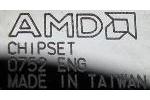|
Gigabyte GA-MA78GM-S2H 780G Review
|
 We put the Gigabyte GA-MA78GM-S2H motherboard with AMD 780G integrated graphics to the test and come away with some impressive results. Without doubt the AMD 780G chipset is a revolution in performance for Home Theatre PCs. We finally have a platform that can playback everything we throw at it without compromises, regardless of the CPU used. It's strange to think that AMD is not only releasing a very inexpensive chipset but it also inadvertently encourages you to buy the cheapest, lowest power CPU possible because it'll still be more than capable thanks to the 780G's Unified Video Decoder UVD engine. For those not wanting to bother with Blu-ray or HD DVD, it'll still save you money because it affords lower power across the board on all common compression types: MPEG-2, H.264 and MPEG-4 Divx/Xvid. But then again, a PC Blu-ray drive isn't that expensive any more - the only thing that's missing is full bitrate High-Definition 7.1 channel audio pass through. Currently PC users are still limited to DVD quality 5.1 channel Dolby Digital and DTS audio. There are other features like Hybrid CrossFire, and the new 2.5GHz 45W AMD Athlon X2 4850e CPU which we will be reviewing separately at a later date, but as far as the chipset goes for use in an HTPC, this is the only option on the market to currently consider. Mind you, Nvidia will soon deliver its GeForce 8200 solution to market, and if Intel's G45 is anything like its G35 in terms of video playback quality, it could give the AMD 780G a run for its money. That said, if Intel's G45-based boards share the same price difference as G35 versus 780G, the AMD solution should remain leagues ahead. It's also important to remember the mobile aspect - even though the M780G isn't going to be available for a little while yet, the dedicated low power processor and very power efficient chipset will increase battery life massively. It'll also allow OEMs to create inexpensive notebooks that can still to handle Blu-ray Disc playback at full HD resolutions. This could give AMD considerable leverage, providing that is, it sorts out its mobile CPUs and makes the platform as good as Centrino (an unlikely event, it has to be said), or alternatively release a mobile north bridge supporting Core 2 CPUs - that's something I can't see happening though, because it goes against the AMD's recent platform advantage marketing campaigns.
We put the Gigabyte GA-MA78GM-S2H motherboard with AMD 780G integrated graphics to the test and come away with some impressive results. Without doubt the AMD 780G chipset is a revolution in performance for Home Theatre PCs. We finally have a platform that can playback everything we throw at it without compromises, regardless of the CPU used. It's strange to think that AMD is not only releasing a very inexpensive chipset but it also inadvertently encourages you to buy the cheapest, lowest power CPU possible because it'll still be more than capable thanks to the 780G's Unified Video Decoder UVD engine. For those not wanting to bother with Blu-ray or HD DVD, it'll still save you money because it affords lower power across the board on all common compression types: MPEG-2, H.264 and MPEG-4 Divx/Xvid. But then again, a PC Blu-ray drive isn't that expensive any more - the only thing that's missing is full bitrate High-Definition 7.1 channel audio pass through. Currently PC users are still limited to DVD quality 5.1 channel Dolby Digital and DTS audio. There are other features like Hybrid CrossFire, and the new 2.5GHz 45W AMD Athlon X2 4850e CPU which we will be reviewing separately at a later date, but as far as the chipset goes for use in an HTPC, this is the only option on the market to currently consider. Mind you, Nvidia will soon deliver its GeForce 8200 solution to market, and if Intel's G45 is anything like its G35 in terms of video playback quality, it could give the AMD 780G a run for its money. That said, if Intel's G45-based boards share the same price difference as G35 versus 780G, the AMD solution should remain leagues ahead. It's also important to remember the mobile aspect - even though the M780G isn't going to be available for a little while yet, the dedicated low power processor and very power efficient chipset will increase battery life massively. It'll also allow OEMs to create inexpensive notebooks that can still to handle Blu-ray Disc playback at full HD resolutions. This could give AMD considerable leverage, providing that is, it sorts out its mobile CPUs and makes the platform as good as Centrino (an unlikely event, it has to be said), or alternatively release a mobile north bridge supporting Core 2 CPUs - that's something I can't see happening though, because it goes against the AMD's recent platform advantage marketing campaigns.
|
|
Quelle: bit-tech.net (E)
|



 We put the Gigabyte GA-MA78GM-S2H motherboard with AMD 780G integrated graphics to the test and come away with some impressive results. Without doubt the AMD 780G chipset is a revolution in performance for Home Theatre PCs. We finally have a platform that can playback everything we throw at it without compromises, regardless of the CPU used. It's strange to think that AMD is not only releasing a very inexpensive chipset but it also inadvertently encourages you to buy the cheapest, lowest power CPU possible because it'll still be more than capable thanks to the 780G's Unified Video Decoder UVD engine. For those not wanting to bother with Blu-ray or HD DVD, it'll still save you money because it affords lower power across the board on all common compression types: MPEG-2, H.264 and MPEG-4 Divx/Xvid. But then again, a PC Blu-ray drive isn't that expensive any more - the only thing that's missing is full bitrate High-Definition 7.1 channel audio pass through. Currently PC users are still limited to DVD quality 5.1 channel Dolby Digital and DTS audio. There are other features like Hybrid CrossFire, and the new 2.5GHz 45W AMD Athlon X2 4850e CPU which we will be reviewing separately at a later date, but as far as the chipset goes for use in an HTPC, this is the only option on the market to currently consider. Mind you, Nvidia will soon deliver its GeForce 8200 solution to market, and if Intel's G45 is anything like its G35 in terms of video playback quality, it could give the AMD 780G a run for its money. That said, if Intel's G45-based boards share the same price difference as G35 versus 780G, the AMD solution should remain leagues ahead. It's also important to remember the mobile aspect - even though the M780G isn't going to be available for a little while yet, the dedicated low power processor and very power efficient chipset will increase battery life massively. It'll also allow OEMs to create inexpensive notebooks that can still to handle Blu-ray Disc playback at full HD resolutions. This could give AMD considerable leverage, providing that is, it sorts out its mobile CPUs and makes the platform as good as Centrino (an unlikely event, it has to be said), or alternatively release a mobile north bridge supporting Core 2 CPUs - that's something I can't see happening though, because it goes against the AMD's recent platform advantage marketing campaigns.
We put the Gigabyte GA-MA78GM-S2H motherboard with AMD 780G integrated graphics to the test and come away with some impressive results. Without doubt the AMD 780G chipset is a revolution in performance for Home Theatre PCs. We finally have a platform that can playback everything we throw at it without compromises, regardless of the CPU used. It's strange to think that AMD is not only releasing a very inexpensive chipset but it also inadvertently encourages you to buy the cheapest, lowest power CPU possible because it'll still be more than capable thanks to the 780G's Unified Video Decoder UVD engine. For those not wanting to bother with Blu-ray or HD DVD, it'll still save you money because it affords lower power across the board on all common compression types: MPEG-2, H.264 and MPEG-4 Divx/Xvid. But then again, a PC Blu-ray drive isn't that expensive any more - the only thing that's missing is full bitrate High-Definition 7.1 channel audio pass through. Currently PC users are still limited to DVD quality 5.1 channel Dolby Digital and DTS audio. There are other features like Hybrid CrossFire, and the new 2.5GHz 45W AMD Athlon X2 4850e CPU which we will be reviewing separately at a later date, but as far as the chipset goes for use in an HTPC, this is the only option on the market to currently consider. Mind you, Nvidia will soon deliver its GeForce 8200 solution to market, and if Intel's G45 is anything like its G35 in terms of video playback quality, it could give the AMD 780G a run for its money. That said, if Intel's G45-based boards share the same price difference as G35 versus 780G, the AMD solution should remain leagues ahead. It's also important to remember the mobile aspect - even though the M780G isn't going to be available for a little while yet, the dedicated low power processor and very power efficient chipset will increase battery life massively. It'll also allow OEMs to create inexpensive notebooks that can still to handle Blu-ray Disc playback at full HD resolutions. This could give AMD considerable leverage, providing that is, it sorts out its mobile CPUs and makes the platform as good as Centrino (an unlikely event, it has to be said), or alternatively release a mobile north bridge supporting Core 2 CPUs - that's something I can't see happening though, because it goes against the AMD's recent platform advantage marketing campaigns.